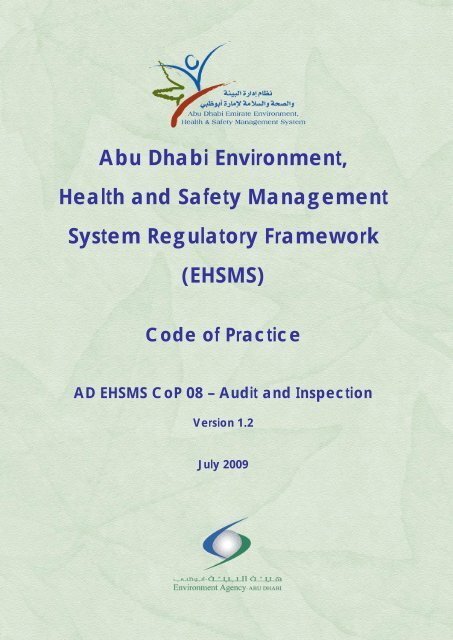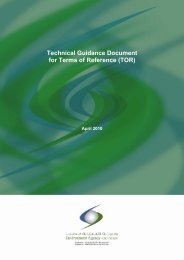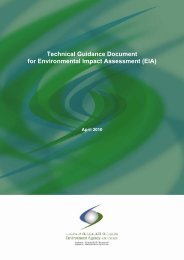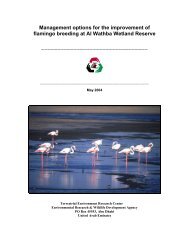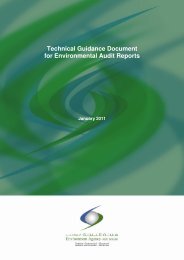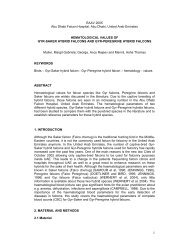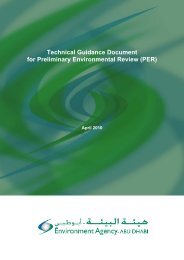Abu Dhabi Environment, Health and Safety Management System ...
Abu Dhabi Environment, Health and Safety Management System ...
Abu Dhabi Environment, Health and Safety Management System ...
Create successful ePaper yourself
Turn your PDF publications into a flip-book with our unique Google optimized e-Paper software.
<strong>Abu</strong> <strong>Dhabi</strong> <strong>Environment</strong>,<strong>Health</strong> <strong>and</strong> <strong>Safety</strong> <strong>Management</strong><strong>System</strong> Regulatory Framework(EHSMS)Code of PracticeAD EHSMS CoP 08 – Audit <strong>and</strong> InspectionVersion 1.2July 2009AD EHSMS CoP 08 – Audit <strong>and</strong> Inspection V1.2 July 20091 of 12
Table of Contents1. Aims <strong>and</strong> Intent..................................................................................................... 31.1 Aims ..........................................................................................................31.2 Intent .........................................................................................................32. Application <strong>and</strong> Implementation ............................................................................ 32.1 Application.................................................................................................33. General Requirements.......................................................................................... 43.1 Planning ....................................................................................................53.2 Responsibilities of EHSMS Auditors..........................................................53.3 Scope of EHSMS Auditing.........................................................................63.4 Managing the Audit Program.....................................................................73.5 Audit Activities...........................................................................................83.6 Managing an EHSMS Audit Program.........................................................93.7 Qualifications for EHSMS Auditing Personnel............................................93.8 Inspections ..............................................................................................10AD EHSMS CoP 08 – Audit <strong>and</strong> Inspection V1.2 July 20092 of 12
Code of Practice for Audit <strong>and</strong> Inspection1. Aims <strong>and</strong> Intent1.1 Aims(a) The aims of the CoP are to:(i) specify the framework in which the process of EHS auditing <strong>and</strong>inspection shall be conducted <strong>and</strong> compliance can be assessedagainst this st<strong>and</strong>ard.1.2 Intent(a) The intent of the Code of Practice is:(i) to guide the management of EHS audit <strong>and</strong> inspection by providing aframework for auditing <strong>and</strong> inspection;(ii) to ensure a systematic approach to EHS audit <strong>and</strong> inspection; <strong>and</strong>(iii) to ensure EHS that non-conformances are identified <strong>and</strong> anappropriate corrective action plan is implemented as early as possible.2. Application <strong>and</strong> Implementation2.1 Application(a) <strong>Health</strong>, safety <strong>and</strong> environment audits may include any or all of the followingitems:(i) compliance with applicable legislation, st<strong>and</strong>ards <strong>and</strong> Codes ofPractices;(ii) review of ’lagging’ <strong>and</strong> ’leading’ indicator statistics;(iii) review of incidents, non-conformances <strong>and</strong> corrective actions;(iv) review of performance against health, safety <strong>and</strong> environment KeyPerformance Indicators (KPl’s); <strong>and</strong>(v) review of site work practices, behaviors <strong>and</strong> systems.(b) The implementation of health <strong>and</strong> safety auditing is to establish that:(i) appropriate management arrangements are in place;(ii) adequate risk control systems exist, are implemented <strong>and</strong> areconsistent with the hazard profile of the organisation; <strong>and</strong>(iii) appropriate workplace precautions are in place.(c) The audit process involves:(i) collecting information about the health <strong>and</strong> safety managementsystem; <strong>and</strong>(ii) making judgements about its adequacy <strong>and</strong> performance.AD EHSMS CoP 08 – Audit <strong>and</strong> Inspection V1.2 July 20093 of 12
(d) An EHS audit shall be a systematic, independent, <strong>and</strong> documented processfor obtaining evidence <strong>and</strong> evaluating it objectively to determine the extentto which the audit criteria are fulfilled (ISO 19011:2003). The process willinclude planning, document review, on-site audit/inspection, issuing of auditfindings, formulation of action plans <strong>and</strong> follow up of the action plans.(e) Qualified professionals with relevant auditing experience can conduct audits<strong>and</strong> where possible, independent external auditors shall also be used. Anaudit team shall comprise a Lead Auditor, <strong>and</strong> a team of experienced,competent persons with the experience in the relevant field (e.g. EMS,OH&S, Risk etc.).(f) Each nominated entity is responsible for controlling the regular frequency ofaudits for its facility or area of management. Line Managers shall besatisfied that appropriate due diligence is being achieved.(g) Audit results shall be documented to identify existing deficiencies <strong>and</strong>required corrective actions. Before being closed out, Corrective ActionRequests shall be followed up to ensure that Non-Conformance’s havebeen corrected. Similarly, other management systems, such as the qualitysystem shall also be corrected, if necessary, to prevent recurrence.(h) Where the provisions of this CoP are inconsistent with the provisions of anyother Emirate <strong>Environment</strong>, <strong>Health</strong> <strong>and</strong> <strong>Safety</strong> Framework Codes ofPractice, the provisions of this CoP shall prevail.3. General Requirements(a) Develop an appropriate Audit Procedure to ensure audits are performed atregular time intervals, including:(i)(ii)(iii)all nominated entities implementing an <strong>Abu</strong> <strong>Dhabi</strong> EHSMS frameworkwill be required to undergo external audits of their EHSMS. The auditshall be performed at least annually as part of the nominated entity’scommitment to demonstrating self-regulation;the annual external audit results shall be submitted to the SectorRegulatory Authority; <strong>and</strong>internal <strong>and</strong> entity self-auditing, performed by qualified in-housepersonnel or third party auditors. The audit findings shall be recorded<strong>and</strong> maintained by the employer.(b) Develop an appropriate Non-Conformance <strong>and</strong> Corrective ActionProcedure; <strong>and</strong>(c) Develop an appropriate Inspection Procedure.AD EHSMS CoP 08 – Audit <strong>and</strong> Inspection V1.2 July 20094 of 12
3.1 Planning(a) The personnel responsible for conducting EHSMS audits within <strong>Abu</strong> <strong>Dhabi</strong>Emirate shall:(i)(ii)(iii)(iv)(v)(vi)ensure the audit team has the appropriate range of knowledge <strong>and</strong>experience to conduct the audit;establish the audit objectives, criteria, extent, <strong>and</strong> scope;define responsibilities of the audit team, allocating adequateresources, <strong>and</strong> developing suitable procedures;implement the audit plan or program;maintain records to demonstrate implementation of the audit program;<strong>and</strong>monitor the implementation of the audit plan or program <strong>and</strong> reviewthe audit plan or program at various stages to determine whether theobjectives have been met <strong>and</strong> to identify areas requiring improvementor that can be improved.(b) To make the EHSMS audit an effective tool that produces reliableinformation for a nominated entity to improve on its EHS performance,EHSMS auditors shall uphold the following principles of auditing:(i)(ii)(iii)(iv)(v)ethical conduct;fairness when presenting audit findings;exercising due care <strong>and</strong> professionalism when conducting the audit;freedom from bias <strong>and</strong> partiality; <strong>and</strong>utilising the logical, scientific, evidence-based approach for arriving atreliable audit conclusions.3.2 Responsibilities of EHSMS Auditors(a) External EHSMS auditors, <strong>and</strong> their audit team, have a primary duty of careto the environment <strong>and</strong> above all to the health <strong>and</strong> safety of the people in<strong>Abu</strong> <strong>Dhabi</strong> Emirate (including their clients). They have ethical as well astechnical obligations in the fulfilment of their duties.(b) Ethically, External EHSMS Auditors are obliged to:(i)(ii)(iii)provide true <strong>and</strong> accurate information concerning their investigations;not issue inaccurate EHSMS audit reports; <strong>and</strong>notify the Relevant Authorities of any imminent hazard to workers, thecommunity or the environment, or fraudulent activity, as soon aspracticably possible during the course of conducting an EHSMS audit,as required by law.(c) Technically, External Auditors are obliged to:AD EHSMS CoP 08 – Audit <strong>and</strong> Inspection V1.2 July 20095 of 12
(i)(ii)(iii)(iv)(v)(vi)refer to the most recent guidelines developed by the RelevantAuthorities <strong>and</strong> updated International St<strong>and</strong>ards in the course ofconducting an EHS audit;utilise best practice methods while conducting assessments;exercise due care, diligence, <strong>and</strong> professional judgement whileconducting their activities to a st<strong>and</strong>ard expected of a qualified EHSAuditor;ensure confidentiality;offer services only in areas within their competence <strong>and</strong> scope ofcertification; <strong>and</strong>ensure that EHSMS audit statements or reports are based on soundobservations <strong>and</strong> logical deductions <strong>and</strong> analysis.3.3 Scope of EHSMS Auditing(a) The scope of EHSMS auditing, for the purposes of implementing theobjectives, principles <strong>and</strong> intent of the EHSMS Framework – the EHSMSminimum requirements as listed in Code of Practice – Self Regulation, shallinclude (where relevant), but not be limited to the following areas:(i)(ii)(iii)(iv)(v)(vi)(vii)(viii)(ix)(x)(xi)(xii)(xiii)EHS <strong>Management</strong> <strong>System</strong>s (Manual, Policies, Procedures, CoP’s,etc);defining <strong>and</strong> communicating EHS roles <strong>and</strong> responsibilities to allrelevant parties;external reporting requirements;regular management reviews;discharges to air, water <strong>and</strong> l<strong>and</strong>;management of water (wastewater, groundwater, drinking water);minimisation <strong>and</strong> management of waste including resource recovery,reuse <strong>and</strong> recycling;hazardous waste management <strong>and</strong> responding accordingly tohazardous releases;managing hazardous substances such as asbestos, pesticides <strong>and</strong> oilpollution;noise management;occupational <strong>and</strong> public health <strong>and</strong> safety (includes workers <strong>and</strong>visitors, customers, neighbours <strong>and</strong> the community) including personalprotective equipment <strong>and</strong> training <strong>and</strong> supervision;adequacy of monitoring <strong>and</strong> measurement practices (includingcalibration);risk assessment <strong>and</strong> management including hazard identification <strong>and</strong>communication;(xiv) hazard identification <strong>and</strong> reporting activities;AD EHSMS CoP 08 – Audit <strong>and</strong> Inspection V1.2 July 20096 of 12
(xv) incident reporting <strong>and</strong> investigation activities;(xvi) audit <strong>and</strong> inspection activities;(xvii) non-conformance <strong>and</strong> corrective action activities; <strong>and</strong>(xviii) emergency management planning <strong>and</strong> response.3.4 Managing the Audit Program(a) An audit program may include one or more audits depending upon the size,nature, <strong>and</strong> complexity of the entity to be audited.(b) An audit program also includes all activities necessary for planning <strong>and</strong>organising the type <strong>and</strong> number of audits <strong>and</strong> for supplying adequateresources to conduct the program effectively <strong>and</strong> efficiently within thespecified timeframe.(c) In addition to their internal audit program, nominated entities shall alsoarrange external audits of their EHSMS. External audits may be useful inproviding a more independent assessment of performance <strong>and</strong> may employexpertise not available in-house.(d) Figure 3-1 illustrates the process-flow for the management of an auditprogram based on the plan-do-check-act methodology described in ISO19011:2003 (Guidelines for quality <strong>and</strong>/or environmental managementsystems auditing).AD EHSMS CoP 08 – Audit <strong>and</strong> Inspection V1.2 July 20097 of 12
Figure 3-1 Process Flow for the <strong>Management</strong> of the Audit ProgramAuthority for the audit programEstablishing the audit program:1. Objectives <strong>and</strong> extent2. Responsibilities3. Resources4. ProceduresPlanActImproving the auditprogramImplementing the audit program:1. Scheduling audits2. Evaluating auditors3. Selecting audit teams4. Directing audit activities5. Maintaining recordsAudit activitiesDoMonitoring <strong>and</strong> reviewing the audit program:1. Monitoring <strong>and</strong> reviewing2. Identifying needs for corrective <strong>and</strong> preventiveaction3. Identifying opportunities for improvementCheck3.5 Audit Activities(a) Figure 3-2 contains guidelines on planning <strong>and</strong> conducting audit activities aspart of the audit program. The extent to which the provisions of theseguidelines are applicable depends on the scope <strong>and</strong> complexity of thespecific audit <strong>and</strong> the intended use of the audit conclusions.(b) ISO 19011:2003 (Guidelines for quality <strong>and</strong>/or environmental managementsystems auditing) provides detailed instructions for implementing auditactivities.AD EHSMS CoP 08 – Audit <strong>and</strong> Inspection V1.2 July 20098 of 12
Figure 3-2 Planning Audit ActivitiesInitiating the audit1. Appointing the audit team leader.2. Defining audit objective, scope, <strong>and</strong> criteria.3. Determining the feasibility of the audit.4. Selecting the audit team.5. Establishing initial contact with the auditee.Conducting document review6. Reviewing relevant management systemdocuments including records <strong>and</strong>determining their adequacy with respect toaudit criteria.Preparing for on-site audit activities7. Preparing the audit plan.8. Assigning work to the audit team.9. Preparing work documents.Conducting on-site audit activities10. Conducting opening meeting.11. Communication during the audit.12. Roles <strong>and</strong> responsibilities of guides <strong>and</strong>observers.13. Collecting <strong>and</strong> verifying information.14. Generating audit findings.15. Preparing audit conclusions.16. Conducting closing meeting.3.6 Managing an EHSMS Audit Program(a) Authority for conducting r<strong>and</strong>om or targeted EHSMS audits shall be grantedby senior management. The audit program shall be designed, developed<strong>and</strong> implemented in accordance with the EHSMS Regulatory Framework.3.7 Qualifications for EHSMS Auditing Personnel(a) Internal EHSMS auditors shall be suitably knowledgeable, experienced <strong>and</strong>qualified to undertake EHS audits.AD EHSMS CoP 08 – Audit <strong>and</strong> Inspection V1.2 July 20099 of 12
(b) External EHSMS auditors shall be suitably knowledgeable, experienced <strong>and</strong>qualified to undertake EHSMS audits (as per the Registration of AuditorsMechanism).(c) The training undertaken by external EHSMS Auditors shall be recognised<strong>and</strong> sufficient to be certified to undertake EHSMS audits of managementsystems in accordance with these st<strong>and</strong>ards, or recognised equivalent.(d) Only auditors registered with the Competent Authority may conduct externalEHSMS audits in accordance with this CoP.3.8 Inspections(a) Inspections refer to a physical walk-through of an area conducted by eitherthe nominated entity or by a Regulatory Agency to determine compliancewith regulations <strong>and</strong>/or sector policies.(b) Nominated entities shall develop, implement, <strong>and</strong> maintain documentedprocedures for planning <strong>and</strong> conducting ongoing inspection, testing, <strong>and</strong>monitoring related to EHS goals <strong>and</strong> targets set earlier. The frequency ofsuch inspection <strong>and</strong> testing shall be appropriate to each item inspected,tested or monitored.(c) In order for the EHS strategy to be effective, it is essential that inspectionsbe planned <strong>and</strong> systematic. This does not remove responsibility fromnominated entities to be vigilant in recognising <strong>and</strong> correcting issues thatthey believe may cause harm or damage.(d) At the completion of each inspection, any deficiencies identified shall benoted on a summary sheet for action.(e) The supervisor (or equivalent) shall then be de-briefed on ways to addressthe key issues identified. Any issues that are identified as continuing shallbe reported to the area manager <strong>and</strong> to the person(s) responsible forEHSMS.(f) It is the responsibility of each nominated entity to develop, with their workteams, the most efficient manner in which such inspections will beperformed. The minimum requirement is that a written procedure forinspections is developed. Figure 3-3 illustrates the process flow forcoordinating workplace safety inspections schedules.AD EHSMS CoP 08 – Audit <strong>and</strong> Inspection V1.2 July 200910 of 12
Figure 3-3Coordinating a Workplace <strong>Safety</strong> Inspection ScheduleStep 1 -Develop register of activities occurring in the organisation’s area ofresponsibility in consultation with the EHS committee.Step 2 - Identify inspection, testing, <strong>and</strong> monitoring required <strong>and</strong> frequency<strong>and</strong> competency by checking sector policies, legislation, <strong>and</strong> st<strong>and</strong>ards.Step 3 - Appoint a staff member to assist in developing plans <strong>and</strong>schedules of inspections, testing, <strong>and</strong> monitoring that determine whethercertificates of competency are needed.Step 4 - Coordinate the implementation of the inspection, testing, <strong>and</strong>monitoring schedule <strong>and</strong> ensure results are documented, reviewed, <strong>and</strong>acted upon <strong>and</strong> records are filed in a systematic manner.AD EHSMS CoP 08 – Audit <strong>and</strong> Inspection V1.2 July 200911 of 12
© <strong>Environment</strong> Agency <strong>Abu</strong> <strong>Dhabi</strong> 2009This document is <strong>and</strong> shall remain the property of the <strong>Environment</strong> Agency <strong>Abu</strong> <strong>Dhabi</strong>. The documentmay only be used for the purposes for which it was intended. Unauthorised use or reproduction of thisdocument is prohibited.Document StatusRevNo.AuthorReviewerApproved for IssueName Signature Name Signature Date0 A. G. JukesAD EHSMS CoP 08 – Audit <strong>and</strong> Inspection V1.2 July 200912 of 12


